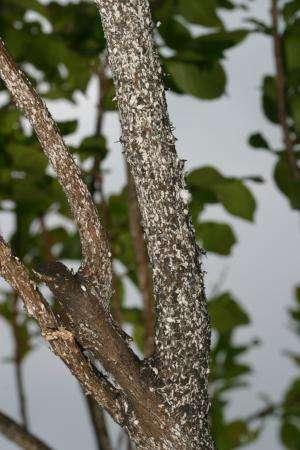New type of scale invader threatens crape myrtle plants

Crape myrtle, a much used Texas landscape plant, is under threat from a new type of scale invader, said two Texas A&M AgriLife Extension Service experts.
Dr. Mike Merchant, AgriLife Extension urban entomologist at Dallas, said the new scale pest turns the bark of crape myrtle trees an ugly black color, and will be bad news to owners of these otherwise beautiful landscape plants.
"We are still figuring out the identity of this insect, but we believe it is Eriococcus lagerstromemia, a scale previously known only from Asia," said Merchant. "We've been referring to it as the crape myrtle bark scale."
Dr. Mengmeng Gu, AgriLife Extension horticulture specialist at College Station, had the chance to see the scale up close in its native China, and her interest in the pest comes from a trip she made there last year.
"It's not pretty," she said. "Crape myrtles we saw in Chinese gardens show the same symptoms as trees here in Texas."
Gu's horticultural contacts in other states revealed that the pest is not restricted to the Dallas area as was previously thought.
"As of today, scale infestations have been found on crape myrtles in North Texas, College Station, Oklahoma, Arkansas, Louisiana and in the Memphis, Tennessee area," she said.
Official confirmation of the scientific name must await verification by molecular biologists and taxonomists, Merchant said. In the meantime, he said the pest continues to spread.
Merchant first discovered the scale on a commercial property at Richardson in 2004.
"We believe someone brought a cutting of crape myrtle that was infested with this scale into the country in luggage," he said. "It's a perfect example of why it's a bad idea to bring home undeclared illegal plant material from other countries."
Merchant said given the presumed scale's range in Asia, it's conceivable that it could spread wherever crape myrtle is grown, even up the Atlantic coast. He said it's also been recorded infesting other plants.
"This scale pest is not limited to infesting crape myrtle," he said. "It's also been recorded on fruit trees like apple and pomegranate. But it's still unclear whether it will pose a significant threat to these other trees, or if crape myrtle is the main host."
Merchant's research on control so far is preliminary, but he's had success in controlling scale with certain insecticides applied to the soil around the base of the crape myrtle trees. The best treatments include products containing imidacloprid, dinotefuran, clothianidin and thiamethoxam. All these products produced significant suppression of the scale for 12 weeks after a single application, he said.
"The black coating on infested trees comes from mold that grows on the excretion products emitted by the scale," Merchant said. "The black trunks detract from the appearance of the trees, and the coating is difficult to remove."
Provided by Texas A&M University





















